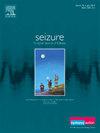Outcomes and responses to anti-seizure medications in status epilepticus: The significance of peri-ictal EEG and MRI abnormalities
IF 2.8
3区 医学
Q2 CLINICAL NEUROLOGY
引用次数: 0
Abstract
Background
Peri-ictal MRI (PMA) and EEG abnormalities (PEA) may predict the outcomes and responses to anti-seizure medications (ASMs) in patients with status epilepticus (SE).
Methods
The inclusion criteria were as follows: (1) patients with SE aged >18 years, (2) peri‑ictal MRI including DWI and FLAIR, (3) peri‑ictal EEG, (4) well-documented medical records, and (5) recruitment between January 2016 and December 2023. Patients with hypoxic-ischemic encephalopathy as the etiology were excluded. Outcomes were classified as good (modified Rankin Scale 0–3) or poor (modified Rankin Scale 4–6) at discharge. Response to ASMs was defined as a failure if SE was not controlled with second-line ASMs at standard doses. PEA was defined as electro-clinical seizures, ictal-interictal continuum, or lateralized periodic discharges. PMA was defined as increased signal intensities in the cortex, thalamus, or hippocampus. A model was developed to predict poor outcomes using multivariate logistic regression with PMA, PEA, and response to second-line ASMs as dependent variables.
Results
A total of 114 patients were included. Poor outcomes were observed in 43.9 % (50/114), and 31 % (35/114) were refractory to second-line ASMs. A multivariate logistic regression predicting poor outcomes identified four variables that were independently associated with poor outcomes (p < 0.0001, R2=0.46): PEA (OR 4.4, 95 % CI 1.68–11.31), PMA (OR 3.8, 95 % CI 1.22–12.1), failure of second-line ASMs (OR 3.7, 95 % CI 1.29–10.84) and status epilepticus severity score (OR 1.6, 95 % CI 1.16–2.13).
Conclusions
PMA, PEA and failure of second-line ASMs were robust predictors of poor outcomes in patients with SE.
癫痫持续状态患者抗癫痫药物治疗的结果和反应:脑电图和MRI异常的意义
背景:周核磁共振(PMA)和脑电图异常(PEA)可以预测癫痫持续状态(SE)患者的预后和对抗癫痫药物(asm)的反应。方法纳入标准为:(1)年龄≥18岁的SE患者,(2)斜周MRI包括DWI和FLAIR,(3)斜周脑电图,(4)文献完备的病历,(5)招募时间为2016年1月至2023年12月。排除病因为缺氧缺血性脑病的患者。出院时预后分为好(改良Rankin量表0-3)和差(改良Rankin量表4-6)。如果不能用标准剂量的二线asm控制SE,则对asm的反应被定义为失败。PEA被定义为电临床发作,发作-间期连续或侧侧周期性放电。PMA被定义为皮层、丘脑或海马的信号强度增加。我们建立了一个模型,以PMA、PEA和对二线asm的反应为因变量,使用多变量逻辑回归预测不良预后。结果共纳入114例患者。43.9%(50/114)的患者预后不佳,31%(35/114)的患者对二线asm难治性。预测不良预后的多变量逻辑回归确定了与不良预后独立相关的四个变量(p <;0.0001, R2=0.46): PEA (OR 4.4, 95% CI 1.68-11.31), PMA (OR 3.8, 95% CI 1.22-12.1),二线asm失败(OR 3.7, 95% CI 1.29-10.84)和癫痫持续状态严重程度评分(OR 1.6, 95% CI 1.16-2.13)。结论spma、PEA和二线asm失败是SE患者不良预后的可靠预测因子。
本文章由计算机程序翻译,如有差异,请以英文原文为准。
求助全文
约1分钟内获得全文
求助全文
来源期刊

Seizure-European Journal of Epilepsy
医学-临床神经学
CiteScore
5.60
自引率
6.70%
发文量
231
审稿时长
34 days
期刊介绍:
Seizure - European Journal of Epilepsy is an international journal owned by Epilepsy Action (the largest member led epilepsy organisation in the UK). It provides a forum for papers on all topics related to epilepsy and seizure disorders.
 求助内容:
求助内容: 应助结果提醒方式:
应助结果提醒方式:


